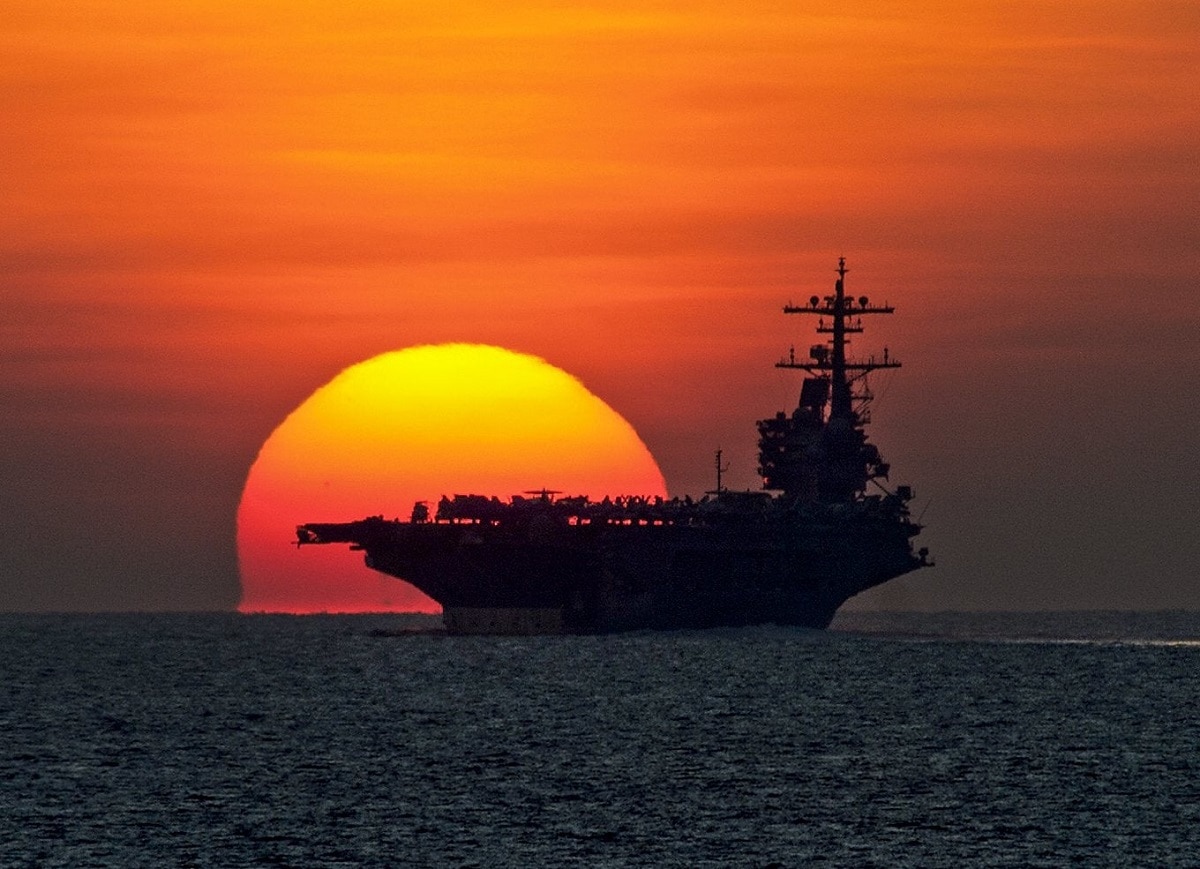Given that the United States Navy’s USS America (LHA-6), at 45,000 tons under full load, is larger than many aircraft carriers in the service of many foreign navies it is easy to see why she might be confused with an actual carrier.
However, America is actually an amphibious assault ship, and her mission is to act as the flagship of an expeditionary strike group or amphibious ready group.
Yet, in the 1970s the U.S. Navy considered a conventional-powered carrier that was to be smaller and more importantly cheaper than the contemporary nuclear-powered Nimitz-class. Thus was born the Aircraft Carrier (Medium) (CCV) program.
Not Quite Supercarriers
Facing a reduced budget following the war in Vietnam, Chief of Naval Operations Admiral Elmo Zumwalt proposed to maintain a large U.S. fleet while at the same time utilizing a mix of very high-end ships and lower-end ships – which even extended to carriers as the Navy looked to replace its aging Midway-class carriers.
The result would be the so-called “Aircraft Carrier (Medium),” meant to supplement the Navy’s existing supercarriers. With just a 908-foot flight deck and able to carry only up to sixty planes – it would be significantly smaller than the supercarriers, but in addition, the carriers would be conventionally powered even as the Navy was going all-in on nuclear-powered carriers.
There would be a few other notable concessions including just two steam catapults instead of the four that were on the supercarriers, which meant that the medium-sized flat tops could only launch planes at half the rate. Likewise, there would be just two elevators instead of three, whilst the smaller airwing would mean the carrier wouldn’t have as great a number of air defense and anti-submarine warfare (ASW) aircraft. Instead, the focus of the CVV would be on its striking power and in that regard, the medium carrier was to be on par with that of a true supercarrier.
Yet, it wasn’t exactly smooth sailing for the CVV program despite the fact that it had the support of both Presidents Gerald Ford and Jimmy Carter. The price tag was a factor.
It was expected that the first of these carriers could cost about $1.5 per ship compared to the $2.4 billion for a fourth Nimitz-class carrier. But it was also determined that the USS John F. Kennedy (CV-67) – the last conventionally powered large carrier built for the U.S. navy – only cost about $100 million more than the CVV, and was far more capable. It was suggested by then-Secretary of Defense Harold Brown in 1978 that the Navy move forward with another John F. Kennedy-class carrier instead.
That idea was rejected by President Carter, who noted that the lower life-cycle costs that came with a smaller ship and smaller airwing. At the same time a fourth Nimitz-class carrier was approved in the Fiscal Year 1981 (FY81) budget – while the election of President Ronald Reagan changed everything. Reagan pushed for – and received – a larger defense budget and the Navy moved forward with nuclear-powered supercarriers. That sank the CVV program.
The 21st Century Medium Carrier
Even as the United States Navy maintains a fleet of eleven supercarriers, many navies around the world have sought to do more with less when it comes to flat tops. The Royal Navy’s flagship HMS Queen Elizabeth II is comparable in size and capability of the proposed CVV, while the navies of Japan and South Korea are also exploring smaller yet still highly capable carrier designs.
These smaller aircraft carriers can operate with short/vertical takeoff and landing aircraft (S/VTOL) including the Lockheed Martin F-35B Lightning II, and thus provide many of the strike capabilities of a larger flagship.
The late Sen. John McCain (R-Arizona) was among the supporters of Zumwalt’s concept including the “high/low mix” of the aircraft carrier fleet.
“Traditional nuclear-powered supercarriers remain necessary to deter and defeat near-peer competitors, but other day-to-day missions, such as power projection, sea lane control, close air support, or counter-terrorism, can be achieved with a smaller, lower cost, conventionally powered aircraft carrier,” McCain stated in his white paper to lawmakers, Restoring American Power.
Given the fact that the latest U.S. Navy carrier, USS Gerald R. Ford, has faced numerous delays while it has gone over budget should make it clear that bigger isn’t always better – especially when hypersonic “carrier killer” missiles pose such a threat today. The cost, maintenance schedule, and last year’s outbreak of Covid-19 on the USS Theodore Roosevelt, which took the carrier out of service for months, also should serve as warning signs why even with nearly a dozen carriers in a conflict the U.S. Navy could come up short by placing so much emphasis on the supercarriers.
There was a case for the CVV program in the Cold War, and an even better case for the medium carriers today.
Peter Suciu is a Michigan-based writer who has contributed to more than four dozen magazines, newspapers and websites. He regularly writes about military small arms, and is the author of several books on military headgear including A Gallery of Military Headdress, which is available on Amazon.com.

